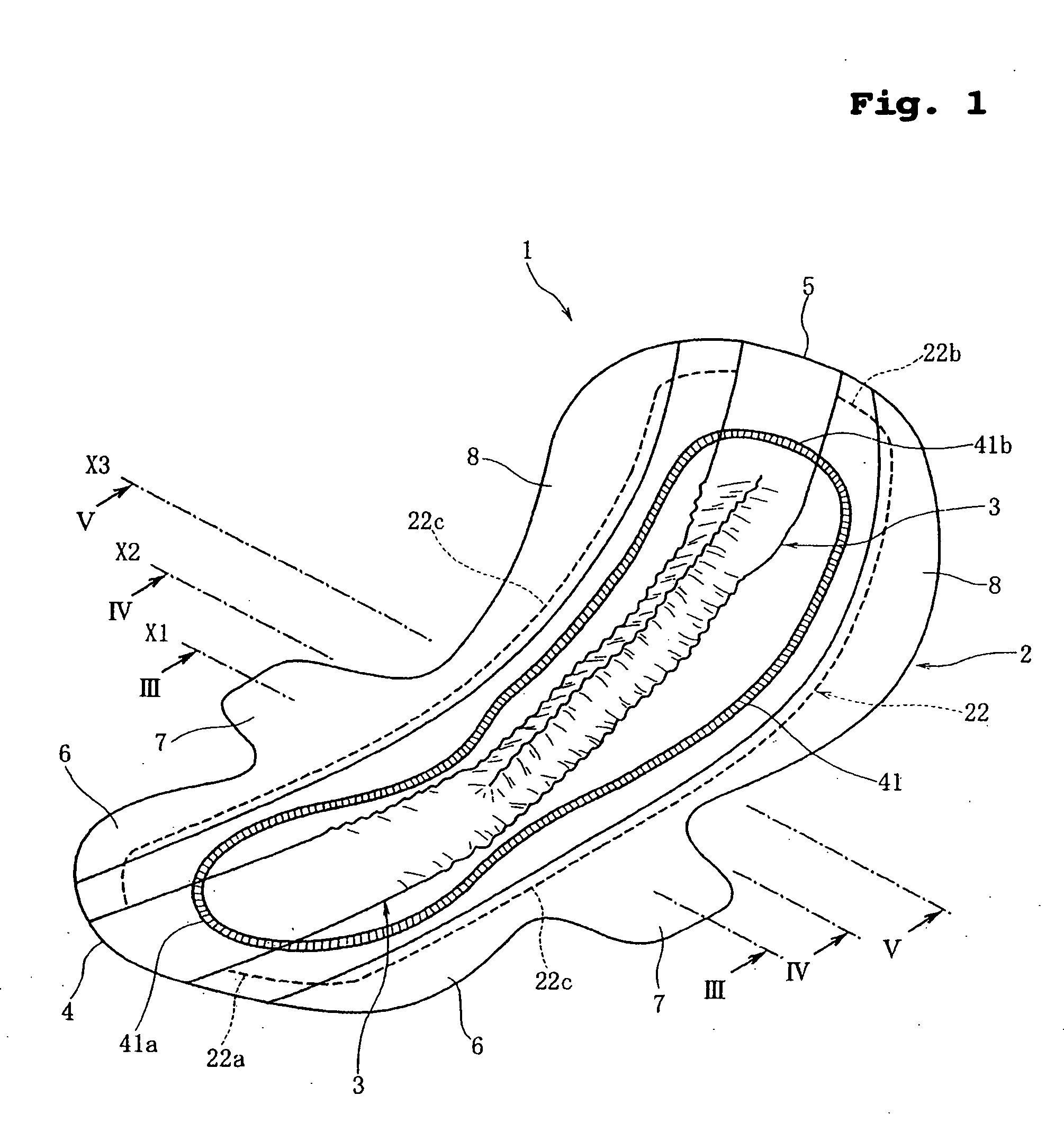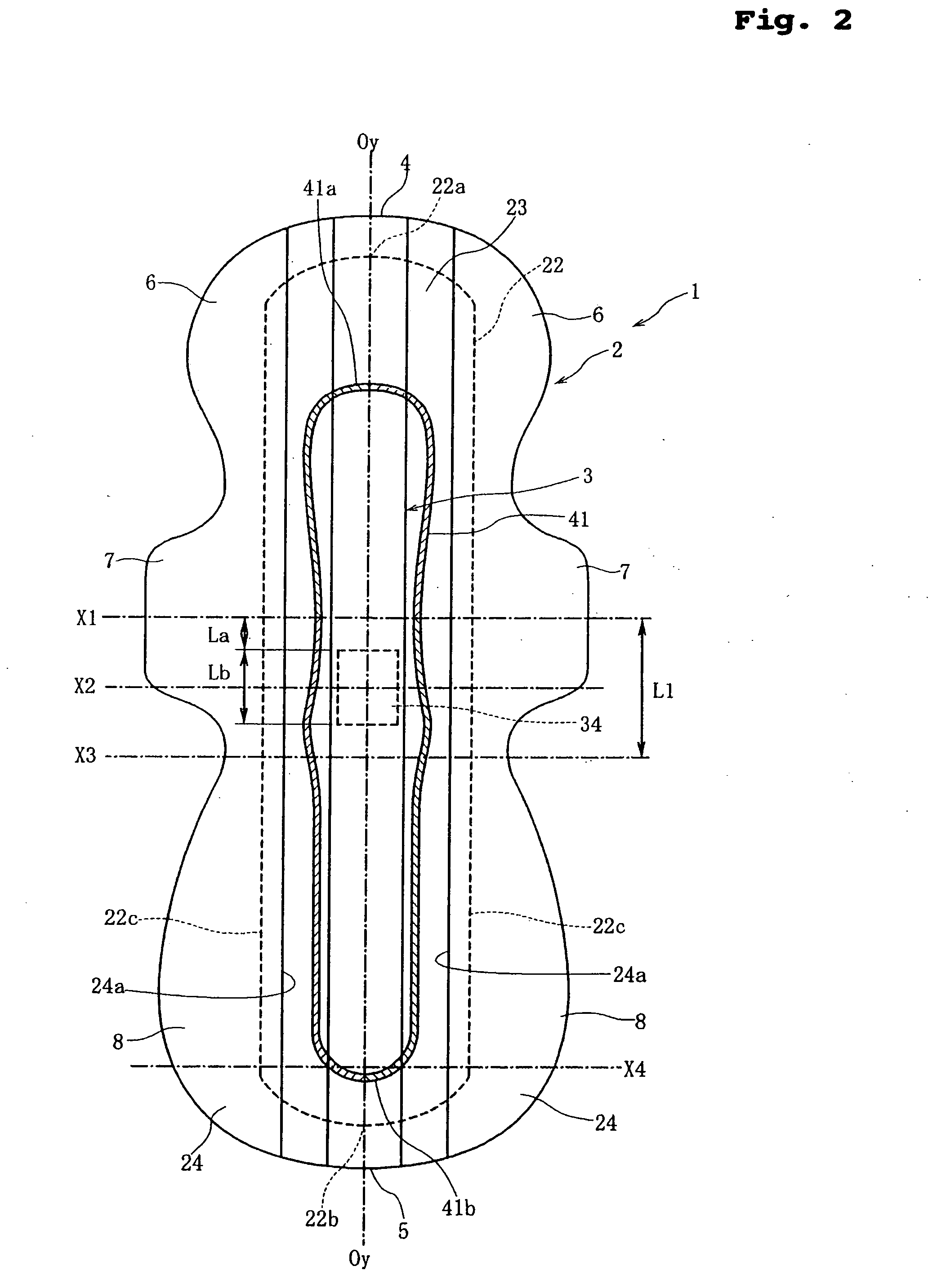Sanitary napkin
a technology of sanitary napkin and sanitary towel, which is applied in the field of sanitary napkin, can solve the problems of inferior compression recovery of enclosure, inability to easily conform to the contour of wearer's crotch, and no upper sheet and lower core, so as to prevent rearward leakage and eliminate clearance
- Summary
- Abstract
- Description
- Claims
- Application Information
AI Technical Summary
Benefits of technology
Problems solved by technology
Method used
Image
Examples
first embodiment
[0052]FIG. 1 is a perspective view of a sanitary napkin according to the present invention in a state where no external force is exerted thereon. FIG. 2 is a plan view showing a body surface of the sanitary napkin in a flattened state. FIG. 3 is a sectional view taken along line III-III of FIG. 1, FIG. 4 is a sectional view taken along line IV-IV of FIG. 1, and FIG. 5 is a sectional view taken along line V-V of FIG. 1. FIG. 6 is a longitudinal sectional view of the sanitary napkin in a state where no external force is exerted thereon. FIG. 7 is a longitudinal sectional view of the sanitary napkin, schematically showing deformation when a body pressure is exerted thereon during wear.
[0053] It should be noted that the sanitary napkin, as well as its individual components, has two major surfaces: of which one surface intended to be worn toward the wearer's crotch is referred to as “body surface”, while the other surface is referred to as “garment surface”. In addition, the lengthwise d...
second embodiment
[0099] The sanitary napkin 101 includes a cover sheet 123 that is disposed on the body surface side of the main body 102 and the projection 103. In the second embodiment, the cover sheet 123 forms not only a part of the main body 102 but also a part of the projection 103.
[0100] The cover sheet 123 is capable of exerting an elastic contractive force at least in the longitudinal direction. The cover sheet 123 may be a nonwoven fabric including crimped fibers as stretchable fibers, for example, a through-air bonded nonwoven fabric. The crimped fibers may be side-by-side bicomponent fibers manufactured by combining two synthetic resin components with different melting points, for example, 2.2 dtex synthetic resin fibers manufactured by combining two polyethylene components with different melting points. The through-air bonded nonwoven fabric may be manufactured by mixing 70 wt. % of the side-by-side bicomponent fibers and 30 wt. % of polyethylene / polypropylene sheath / core bicomponent fi...
third embodiment
[0119] The sanitary napkin 201 has a main body 202 and a projection 203. A cover sheet 223 is disposed on the body surface side of the main body 202 and the projection 203. In the third embodiment, the cover sheet 223 forms not only a part of the main body 202 but also a part of the projection 203.
[0120] The cover sheet 223 is a nonwoven fabric that is stretchable in the longitudinal direction, for example, a through-air bonded nonwoven fabric identical to that used for the projection topsheet 31 of the first embodiment. In order to make the cover sheet 223 easily stretchable in the longitudinal direction, the through-air bonded nonwoven fabric or another type of nonwoven fabric such as spunlaced nonwoven fabric may be corrugated to have ridge and grooves extending in parallel to the lateral direction. In the compression line 41, as shown in FIG. 17, the cover sheet 223 is heated and pressed together with the liquid-absorbent layer 22. The area enclosed by the compression line 41 is...
PUM
 Login to View More
Login to View More Abstract
Description
Claims
Application Information
 Login to View More
Login to View More - R&D
- Intellectual Property
- Life Sciences
- Materials
- Tech Scout
- Unparalleled Data Quality
- Higher Quality Content
- 60% Fewer Hallucinations
Browse by: Latest US Patents, China's latest patents, Technical Efficacy Thesaurus, Application Domain, Technology Topic, Popular Technical Reports.
© 2025 PatSnap. All rights reserved.Legal|Privacy policy|Modern Slavery Act Transparency Statement|Sitemap|About US| Contact US: help@patsnap.com



